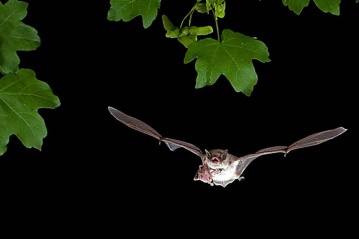News from 08/17/2021
 By Helmi Tischler-Venter
By Helmi Tischler-Venter
According to the Federation for the Environment and Nature Conservation (BUND), there are 24 bat species in Germany, only two of which are currently considered to be harmless. 16 are even on the “Red List” for endangered species. Although there is great interest in insect hunters, humans are responsible for their decline.

Region. The number of bats in Germany has decreased dramatically since the middle of the 20th century. The cause is, on the one hand, intensive agriculture and forestry, which, for example, destroy their food sources through the use of insecticides. The corresponding decline in insects has been clearly identified and complained about in recent years. When it gets dark, they hunt for insects with the help of their location sounds in the ultrasonic range. On the other hand, the bat habitats are dwindling. Many traditional neighborhoods are falling victim to tree felling and building renovation. Entire bat colonies have also been wiped out by toxic wood preservatives.
Disturbances in winter quarters are particularly fatal: Frightened animals can lose so much energy that they no longer wake up from hibernation in spring. This is why many nature conservationists are committed to protecting bats by recording their summer quarters, setting up winter quarters, providing sealed tunnels with passageways, lifting up damaged and weakened animals and advising homeowners or parishes in whose roofs and cellars bats have set up.
Every year groups of the Naturschutzbund (NABU) take part in the European Bat Night with guided tours in the dark and creative activities that are intended to answer many interesting questions from children and adults.
For example:
How do bats orient themselves in total darkness? Do bats suck blood? How can you sleep upside down without falling off? How do bats reproduce?
During the day, the goblins can hardly be seen at night. They prefer to inhabit old, cave-rich trees. The small pygmy bat and the much larger broad-winged bat are particularly common in residential areas. There they usually live unnoticed under cladding or in voids in walls as well as in old barns, on whose ridge beams they like to hang in colonies. Your quarters are always close to bodies of water, ponds and creeks that promise rich hunting prey.
Experience shows that nesting boxes are only a poor substitute. Some bat species accept them, but when they try to spend the winter in them, they often freeze to death.
Most noticeable are the forelimbs with claws, which have been transformed into wings. That means: bats fly with their hands. Instead, they see with their ears and sleep with their heads down. The interesting animals can be attracted with insect and bat-friendly gardens. If you can watch them in your own garden, you will soon find that bats are not a bit scary, but rather fascinating flying artists who show all their skills in the evening hours.
The BUND recommends: If bat roosts are threatened, please contact the nature conservation authority in your district or city. (htv)
Become a fan of the NR-Kurier.de local edition Dierdorf on Facebook!
– .


